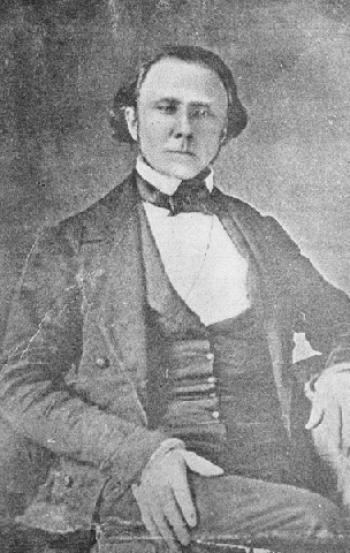 | ||
The Cherokee in the American Civil War were active in two major regions. In the east, Confederate Cherokee led by William Holland Thomas hindered Union forces trying to use the Appalachian mountain passes of western North Carolina and eastern Tennessee. Out west, Stand Watie, who was 3/4 Cherokee, led Confederate forces in the Indian Territory, in what is now the state of Oklahoma.
Contents
Eastern front
The Thomas' Legion, led by William H. Thomas, European-American who was adopted Cherokee, were originally stationed outside Knoxville, Tennessee at Strawberry Plains, Tennessee. Their primary duty was to protect the Alum Cave, and harass Union troops that invaded Tennessee. While briefly working around Chattanooga, Tennessee in June 1862, Thomas personally captured a Union Soldier, after which each of his men vowed to capture at least one "Yankee" before the war was over.
The Legion would become infamous due to their actions on September 15, 1862. While trying to stop a Union advance through Baptist Gap, a popular leader among the Cherokee, Astoogahtogeh, was killed leading a charge. Enraged, the remaining Cherokee were driven to avenge him. In retaliation for Astoogahtogeh's death, the Cherokee scalped the dead Union soldiers after the battle. After the event was reported in newspapers, Union soldiers would fear the Cherokee, but Thomas feared for the reputation of the Cherokee, as he did not want his people seen as barbaric. The scalps were sent to be buried with the soldiers they originally came from.
After a number of Thomas' men were captured in February 1864, some were convinced by the Union that they were fighting for slavery, and thereafter fought for the Union. Others convinced their captors they also would defect to the Union side, but instead went back to Thomas and told him Union officials offered $5,000 for Thomas' scalp. After this, many of his men were sent to fight in Virginia, some of whom were present at Appomattox Court House for General Robert E. Lee's surrender. The rest of the Legion continued to fight until surrendering along with the commanding officer of the District of Western North Carolina to the Union commander they had captured on 10 May 1865.
Western front
In the west, the Cherokee blamed the federal government and former United States President Andrew Jackson for the Trail of Tears. Also, they had adopted Southern ways before their removal from their Appalachia home, including the practice of owning blacks as slaves. So, the western Cherokee were already sympathetic towards the South when in 1860 William Seward, campaigning on behalf of Abraham Lincoln, said that Lincoln would open the Indian Territory for white settlement.
Chief of the Cherokee John Ross was adamant that the Union was not dissolved. However, another leader of the Cherokee, Stand Watie, was eager to join the Confederate cause, and on June 1, 1861, began recruiting for an army to assist the Southern cause. Full-blooded Cherokee tended to support Ross (who was actually 7/8 Scottish) while the mixed-blooded Cherokee supported the 3/4 Cherokee Stand Watie. Stand Watie in 1862 was elected Chief of the Southern Cherokee Nation.
For the duration of the war, a series of small battles were waged by Cherokee in the Indian Territory. Stand Watie officially became the last Confederate general to end fighting on June 25, 1865 at Fort Towson, in the southeast portion of the Indian Territory. The terms of the armistice allowed Watie and his command, the First Indian Brigade of the Army of the Trans-Mississippi, to demobilize rather than surrender and go home with their arms.
Aftermath
The eastern Cherokee faced a severe smallpox outbreak following the war. Thomas and many of his followers were deeply in debt, to the point that the federal government recognized the eastern tribe as separate from the western tribe, and filed a lawsuit against the Cherokee's creditors, in effect leaving the protection of the Cherokee to the federal government.
In the west, at the end of the war, with the Union victorious, the Union Cherokee established policies that confiscated land from the Confederate Cherokee. The Federal government promised the Confederate Cherokee that the laws promoting the confiscation would be annulled. This was due to Indian Commissioner D.N. Cooley, who saw opportunities in splitting the factions of the Cherokee, as represented by Ross and Watie. Cooley even went as far as to portray Ross as a traitor, when Ross had always been a Union advocate. The Cherokee were forced to adopt their slaves into the tribe, and to allow settlement of their lands by whites. In effect, due to the Cherokee split and the maneuverings of Cooley, the Cherokee suffered the worst of Reconstruction.
